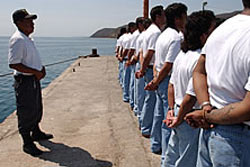 |
 |
 |
 News from Around Banderas Bay | May 2005 News from Around Banderas Bay | May 2005  
Island Jail Gets New Inmates At 100-Year Mark
 Eduardo Verdugo - Associated Press Eduardo Verdugo - Associated Press


| | Newly arrived inmates stand at attention on the pier of the Islas Marias federal prison island on Thursday, as the last island penal colony in the hemisphere marked its 100th anniversary (Photo: AP) |
Islas Marías, Nayarit - Marking the 100th anniversary of the Western hemisphere's last functioning island penal colony, Mexico's Islas Marías penitentiary welcomed about 90 new prisoners, the latest bid to revive an island facility that was once slated for closure.

During the anniversary ceremony Thursday, Public Safety Secretary Martín Huerta pledged an additional US9.1 million in investments to increase security and preserve the environment on the island. Huerta plans to double the inmate population to about 1,200.

Inmates like 38-year-old Rubén González are allowed to live in their own modest homes with few restrictions, and even bring their families to live with them on the island, which boasts a school, an arts and crafts workshop and a musical group.

González, with two years left to go on an eight-year sentence, runs a small store selling water, soft drinks and snacks on María Madre, the largest of the four Marías islands located 70 miles (112 kilometers) off Mexico's southern Pacific coast.

The revival of the penal colony in 2004 as an alternative for non-dangerous inmates angered conservationists like Ramón Ojeda Mestre, who spent several years helping direct the complicated clean-up at the islands, home to unique yellowheaded parrots and brown hummingbirds.

Environmentalists had planned to reforest the land, withdraw non-native species, decrease the prison population and eventually turn the islands into a nature reserve. They say prisoners, with their hunting, farming and ranching activities, hurt local species.

Prisoners both help care for and exploit island resources. They acknowledge eating iguanas, for example, but say they wait until after the lizards have laid their eggs and guaranteed the next generation.

Juan Salazar, 43, said things have improved since he arrived in 1982.

"When I arrived, things were different. There was forced labor on the salt flats, punishment was harsh," said Salazar, who has another three years left to serve. "Now, things are much better." Founded on May 12, 1905, Islas Marías was one of many such island penal colonies in the Americas at the time. Intended to be more self-sufficient and escapeproof, the most famous was the French prison on Guiana's Devil's Island, the subject of the 1973 movie "Papillon."

Since then, the others were gradually closed. The only other such penal colony in the Americas, Panama's Coiba Island, was closed and slated for conversion to a nature reserve in late 2004. | 
 | |
 |



